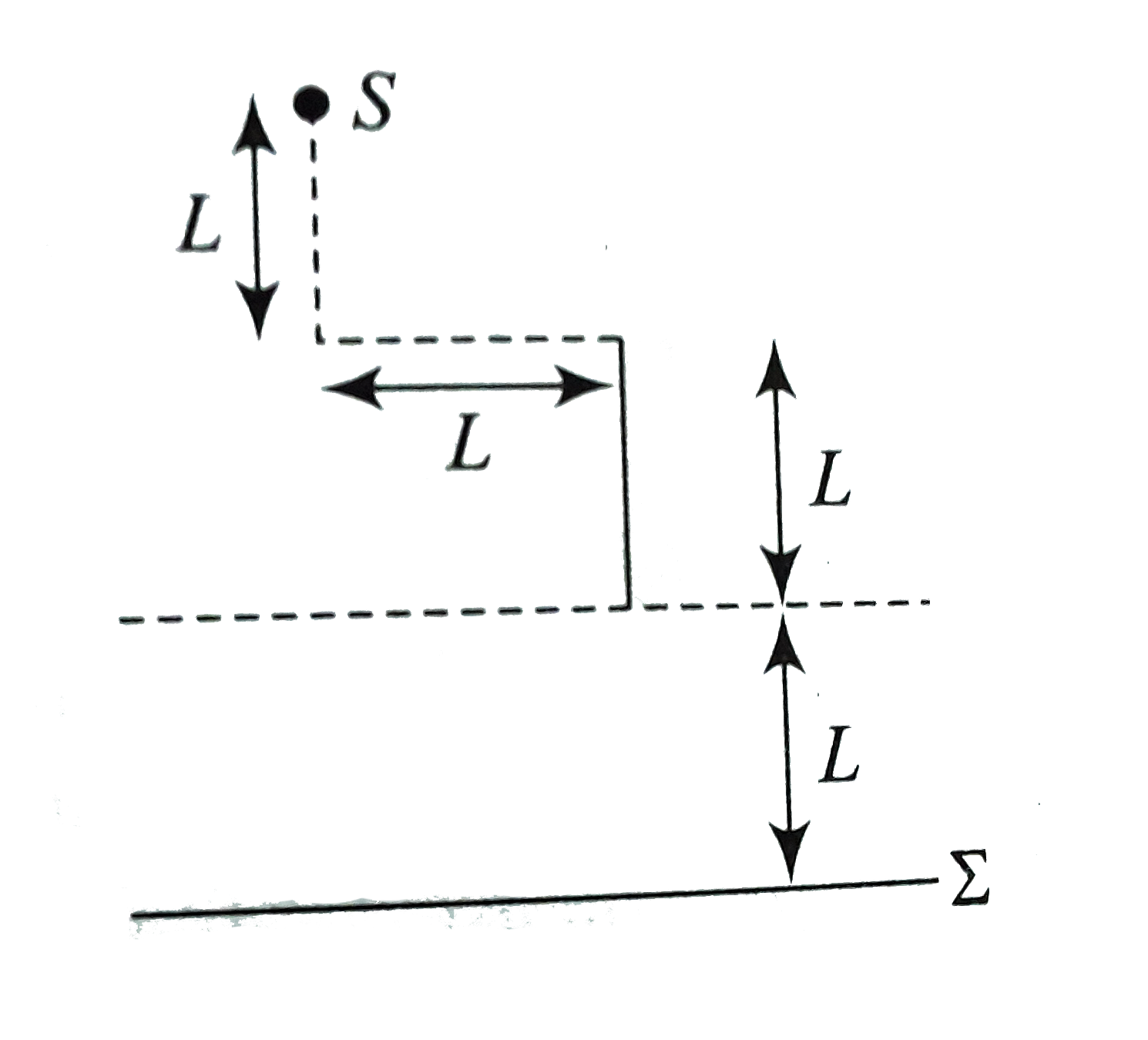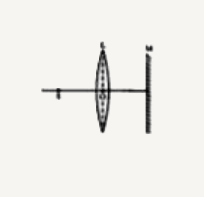A totally reflecting, small plane mirror placed horizontally faces a parallel beam of lighy as shown in figure. The mass of the mirror is 20g. Assume that there is no absorption in the lens and that 30% of the light emitted by the source goes through the lens. Find the power of the source needed to support the weight of the mirror. Take g=10ms−2.
 Solution in Tamil
Solution in Tamil
Here m=20g=20×10−3kg
The weight of the mirror is balanced. So, force exerted by the photons is equal to weight .
P=hλandE=hcλ=Pc
⇒Et=Ptc
⇒Rate of change of momentum
= power//c<br>30%oflightpassesthroughthe≤ns.<br>Thusitexertsforce,70%isref≤cted<br>:. Force exerted - 2
(rate of change of momentum)
=2×Power/c
30%(2×Powerθ)=mg
⇒Power=20×10−3×10×3×103×102×3
=10Wpower=100MW.
Topper's Solved these Questions
- BOOK - HC VERMACHAPTER - PHOTO ELECTRIC EFFECT AND WAVE PARTICLE DUALITYEXERCISE - objective II7videos
PHOTO ELECTRIC EFFECT AND WAVE PARTICLE DUALITY
- BOOK - HC VERMACHAPTER - PERMANENT MAGNETSEXERCISE - Exercise25videos
PERMANENT MAGNETS
- BOOK - HC VERMACHAPTER - PHOTOMETRYEXERCISE - All Questions44videos
PHOTOMETRY
Similar Questions
When the intensity of a light source is increased.
04:46View SolutionA long bar magnet has a pole strength of 10Am. Find the magnetic field at a point on the axis of the magnet at a distance of 5cm from the north pole of the magnet.
01:28View SolutionFind the luminous flux of 10 W source of 600 nm. The relative luminosity at 600 nm is 0.6.
01:15View SolutionA converging lens and a diverging mirror are placed at a separation of 15 cm. The focal length of the lens is 25 cm and that of the mirror is 40 cm. Where should a point source be placed between the lens and the mirror so that the light, after getting reflected by the mirror and then getting transmitted by the lens, comes out parallel to the principal axis ?
07:30View SolutionA point source of light is placed in front of a plane mirror as shown in Figure.
Determine the length of reflected path of light on the screen Σ
 02:29View Solution
02:29View SolutionA diverging lens of focal length 10cm is placed 10cm away in front of a plane mirror as shwon in figure. Light from a very far away source falls on the lens. An observer is situated some where in between lens and mirror, and observer is looking towards mirror. The observer will see the image behind teh mirror at a distance.
11:26View Solution
A totally reflecting, small plane mirror placed horizontally faces a parallel beam of light as shown in the Fig. The mass of the mirror is 20 g. Assume that there is no absorption in in the lens and that 30% of the light emitted by the source goes through the lens. Find the power (in×108W) of the source needed to support the weight of the mirror. Take g=10ms−203:28View SolutionThe separation between the screen and a plane mirror is 2 r . An isotropic point source of light is placed exactly midway between the mirror and the screen. Assume that mirror reflects 100% of incident light. Then the ratio of illuminances on the screen with and without the mirror is
04:19View SolutionA point source of radiation power P is placed on the x-axis of an ideal plane mirror. The distance between the source and the mirror is n times the radius of the mirror. Find the force that light exerts on the mirror.
04:20View SolutionA converging lens and a diverging mirror are placed at a separation of 20 cm. The focal length of the lens is 30 cm and that of the mirror is 50 cm. Where should a point source be placed between the lens and the miror, so that the light, after getting reflected by the mirror and then getting transmitted by the lens, comes out parallel to the principal axis?
04:16View Solutionएक उत्तल लेंस और एक समतल दर्पण की बीच दूरी 10 सेमी हैं | उत्तल लेंस पर गिरने वाली समान्तर किरणें दर्पण से परावर्तित होकर लेंस के प्रकाशिक केंद्र पर प्रतिबिम्ब बनती हैं | किरण-आरेख खींचकर, लेंस की फोकस-दूरी ज्ञात कीजिए |
03:17View SolutionA totally reflecting small plane mirror placed horizontally faces a parallel beam of light as shown in the figure. The mass of the mirror is 200 g. Assume that there is no absorption in the lens and that 20% of the light emitted by the source goes through the lens. The power of the source needs to support the weight of the mirror is P xx 10^(8) watt, where P is [take g = 10 ms^(-2) ]
03:56View SolutionA converging lens and a diverging mirror are placed at a separation of 15 cm. The focal length of the lens is 25 cm and that of the mirror is 40 cm. Where should a point source be placed between the lens and the mirror so that the light, after getting reflected by the mirror and then getting transmitted by the lens, comes out parallel to the principal axis ?
02:17View SolutionA diverging lens with a focus distance of 10 cm is placed at a distance of 10 cm in front of a plane mirror, as shown in the figure. The light from a light source located far away is incident on the lens. Will the final image be made at a distance?
04:39View SolutionA converging lens and a diverging mirror are placed at a separation of 20 cm. The focal length of the lens is 30 cm and that of the mirror is 50 cm. Where should a point source be placed between the lens and the miror, so that the light, after getting reflected by the mirror and then getting transmitted by the lens, comes out parallel to the principal axis?
06:32View SolutionThe diagram shows a point source of light S, a convex lens L and plane mirror M. These are placed such that rays of light from S return to it after reflection from M.

What is the distance OS called?View Solution

